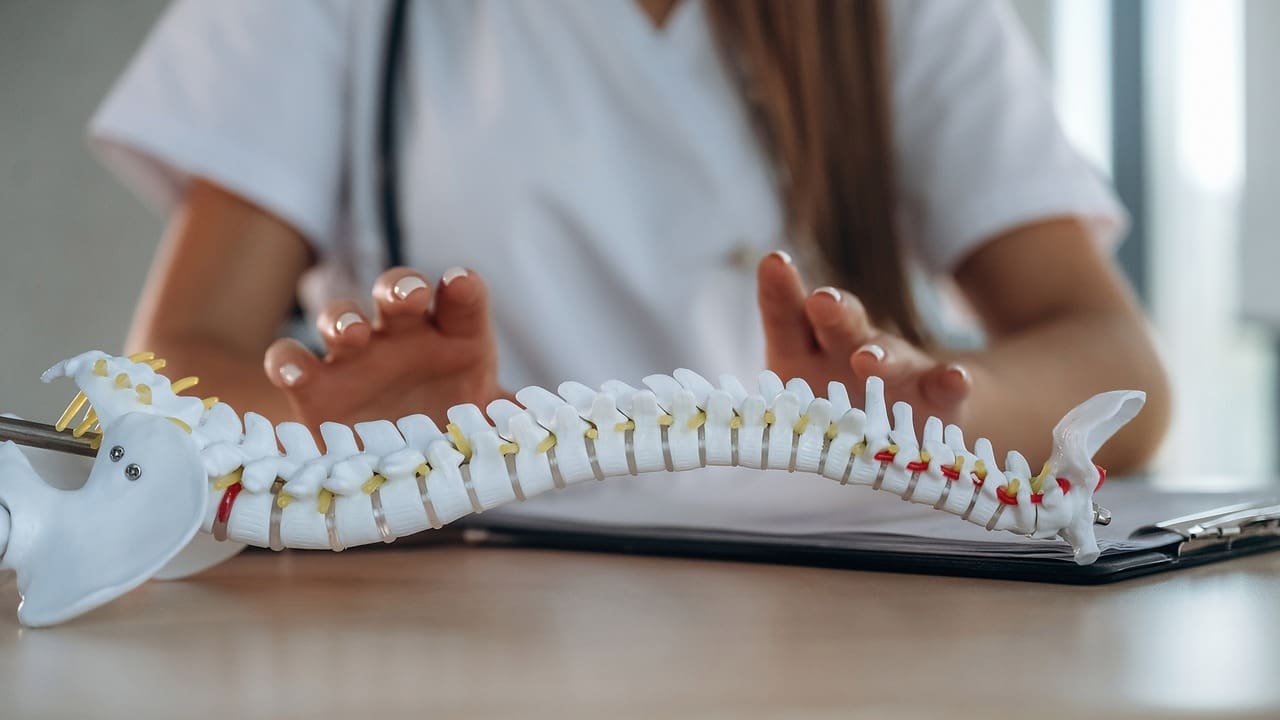Last Updated on November 4, 2025 by mcelik

Lumbar spine compression can cause a lot of pain and make it hard to move. Problems like spondylolisthesis and Bertolotti’s syndrome can lead to this. Symptoms include pain in the legs, weak muscles, and trouble with bowel or bladder control.
At Liv Hospital, we focus on the latest treatments for lower back compression. Our team works hard to help patients move better and feel less pain.
It’s important to know what causes compressed lower spine and how to treat it. We’ll cover all you need to know to help our patients get better.

Knowing what causes and increases the risk of lumbar spine compression is key. It helps in preventing and treating the issue. Many factors can affect the spine’s structure and function.
Lumbar spine compression often comes from degenerative changes. This includes degenerative disc disease and spondylolisthesis. Degenerative disc disease wears down the discs between vertebrae, causing nerve compression. Spondylolisthesis, where a vertebra slips over another, is another major cause.
Several factors increase the risk of spinal compression. These include:
It’s important to know the difference between disc and cord compression. Disc compression affects the discs between vertebrae. Cord compression affects the spinal cord itself. Cord compression can lead to severe neurological problems.
Understanding these differences is critical for the right treatment. Healthcare providers can tailor treatments based on the specific cause and type of compression. This helps in reducing symptoms and preventing further issues.

Radiating pain is a key sign of spinal compression, showing nerve issues. This pain happens when nerves from the compressed area get irritated or damaged. It causes discomfort that spreads along the nerve’s path.
Spinal compression in the lower back can send pain to the legs. This is often linked to sciatica, where the sciatic nerve gets compressed. It leads to pain, numbness, or weakness in the legs. The pain’s intensity can range from mild to severe.
Cervical compression in the neck can cause arm pain. It happens when nerves from the cervical spine get affected. Symptoms include pain, tingling, or weakness in the arms or hands. Pain can worsen with certain neck movements.
Radiating pain is a serious symptom, but it can also signal a medical emergency. Sudden, severe, or ongoing pain, with numbness, weakness, or loss of bladder/bowel control, needs immediate care. Spotting these signs early is key to avoiding serious harm.
Muscle weakness and atrophy are big warning signs of spinal compression. They need quick medical help. When nerves get compressed, muscles don’t work right, causing weakness and atrophy if it lasts too long.
Lumbar compression usually makes the legs weak. This makes moving and doing daily tasks hard. The weakness can be on one side or both, based on how bad the compression is.
Cervical compression makes hands and arms weak. It hurts fine motor skills and grip strength. This makes it hard to do tasks that need precision.
| Compression Type | Affected Area | Symptoms |
|---|---|---|
| Lumbar Compression | Legs | Weakness, Mobility Issues |
| Cervical Compression | Hands and Arms | Weakness, Impaired Fine Motor Skills |
Compression-related weakness gets worse over time if not treated. Spotting symptoms early and acting fast is key. It helps avoid lasting damage and improves results.
Neurological symptoms like numbness and tingling can signal nerve compression. These feelings happen when nerves in the spine get squished. This disrupts how nerves work. We’ll look at how these symptoms show up in different body parts, based on where the nerve compression is.
When the lower spine is compressed, numbness and tingling often hit the legs. This is because the nerves running from the lower back to the legs get affected. Knowing where these feelings show up can help figure out where the compression is.
For example, if nerves at the L4-L5 or L5-S1 levels get squished, you might feel numbness or tingling in your thighs, calves, or feet. It’s important to understand these patterns to diagnose and treat correctly.
Cervical vertebrae compression can cause numbness and tingling in the arms and hands. The exact areas affected can tell us where the compression is in the cervical spine. For instance, if nerves at the C6 or C7 level get squished, you might feel symptoms in different parts of your arm and hand.
The way numbness or tingling shows up in your fingers can give us important clues about cervical nerve compression. For example, if you feel numbness in your thumb and index finger, it might mean there’s compression at a certain cervical level.
Let’s look at how specific finger patterns can help diagnose:
| Finger(s) Affected | Likely Level of Compression | Common Symptoms |
|---|---|---|
| Thumb and Index Finger | C6 | Numbness, tingling |
| Middle Finger | C7 | Numbness, weakness |
| Little Finger | C8 | Tingling, pain |
Bowel and bladder problems can be signs of serious spinal cord compression. These issues happen when nerves controlling these functions get compressed.
Cauda Equina Syndrome (CES) is a serious condition linked to these problems. It’s a medical emergency that needs quick action. CES happens when nerves in the lower spine get compressed, causing loss of function in the bladder, bowel, and legs.
If not treated, CES can cause permanent damage. This includes incontinence and paralysis.
We must know the signs of CES, which include:
For more information on CES, visit the American Academy of Orthopaedic Surgeons website.
Autonomic dysfunction affects the autonomic nervous system. It shows through early warning signs. These include:
Spotting these signs early is key. It helps in getting timely treatment and avoiding long-term damage.
Getting medical help right away is vital for treating severe spinal compression. Waiting too long can cause permanent damage. This includes chronic pain, muscle weakness, and bowel and bladder problems.
Quick medical care can greatly improve outcomes. It can help restore function.
Coordination and balance issues are big problems for people with spinal compression. They make moving around hard. Simple tasks become big challenges.
Spinal compression shows up in different ways. It depends on where and how bad it is. For example, lower back issues might change how you walk. Cervical spine problems can mess with hand movements.
Lower back compression often leads to changes in how you walk. When the spinal cord or nerves get squished, it messes with leg signals. This makes walking normally hard.
This can cause an odd gait. It might also lead to more pain or injury.
Cervical spine compression can mess with hand coordination. It affects nerves that control hand movements. This makes doing precise tasks hard.
Ventral cord compression impacts balance a lot. It affects the front part of the spinal cord. This can mess up balance and increase fall risks.
It’s key to understand how spinal compression affects coordination and balance. This helps manage mobility and prevent falls. If you notice these symptoms, see a doctor.
Diagnosing a compressed spine is a detailed process. It includes a physical check-up and tests of the nervous system. This thorough check is key to finding out how serious the compression is.
The first step in diagnosing spinal compression is a detailed physical check. Doctors check muscle strength, reflexes, and how sensitive you are. They use special moves to make symptoms appear, helping pinpoint the problem nerve.
MRI and CT scans are vital for confirming the diagnosis. MRI shows soft tissues like nerves and discs in detail. CT scans are great for seeing bones. Together, they show how serious the compression is.
Neurological tests are key to checking the spinal cord’s function. They include electromyography (EMG) and nerve conduction studies (NCS). These tests check how nerves work and find damage.
When C5-6 compression is suspected, special tests are used. These tests check arm and hand strength, reflexes, and for numbness or tingling. They help confirm if the C5 and C6 nerve roots are compressed.
| Diagnostic Method | Purpose | Key Findings |
|---|---|---|
| Physical Examination | Assess neurological function and identify areas of tenderness | Muscle weakness, reflex changes, sensory deficits |
| MRI | Visualize soft tissues, nerves, and discs | Nerve root compression, disc herniation, spinal cord impingement |
| CT Scan | Visualize bony structures | Bone spurs, fractures, degenerative changes |
| Neurological Tests (EMG/NCS) | Assess nerve root function and detect nerve damage | Abnormal nerve conduction, muscle denervation |
Non-surgical treatments are often the first step in managing spinal cord compression. Each patient’s situation is different. A detailed treatment plan is key for effective care.
Medicines are important for treating spinal cord compression symptoms. We use nonsteroidal anti-inflammatory drugs (NSAIDs) to lessen inflammation and pain. Sometimes, corticosteroids are given to reduce swelling around the compressed area.
Physical therapy is a mainstay in treating spinal cord compression without surgery. Our physical therapists create special exercise plans. These plans aim to improve flexibility and strengthen muscles around the spine, easing pressure on the spinal cord.
Bracing and support devices help stabilize the spine, easing discomfort. We suggest customized orthotics or braces to support the spine and promote proper alignment. This is very helpful during the healing process.
We also look at alternative and complementary therapies. Chiropractic care and acupuncture are treatments some patients find helpful. These therapies can be used alongside traditional treatments to improve overall well-being.
By using these non-surgical treatments in a complete care plan, we can manage spinal cord compression well. This improves our patients’ quality of life.
Severe spinal cord compression often needs surgery to reduce pressure and stop further damage. If other treatments don’t work, surgery is a key option for those with this condition.
Minimally invasive decompression procedures aim to ease spinal cord pressure with little tissue harm. They use smaller cuts and cause less muscle damage than old-school surgeries. This leads to faster healing times.
Benefits of Minimally Invasive Surgery:
For complex spinal cord compression, traditional surgery might be needed. These surgeries do more extensive decompression or spine stabilization to fix the compression’s cause.
Indications for Traditional Surgery:
Emergency surgery is sometimes needed when there’s quick neurological decline. Quick action is key to prevent permanent harm and improve outcomes.
The recovery and rehab time after spinal cord compression surgery vary. It depends on the surgery’s complexity and the patient’s health. A detailed rehab plan is vital for getting strength and mobility back.
| Procedure | Typical Recovery Time | Rehabilitation Focus |
|---|---|---|
| Minimally Invasive Decompression | 2-6 weeks | Pain management, physical therapy |
| Traditional Surgical Approaches | 6-12 weeks | Stabilization, strength training |
| Emergency Surgery | Varies | Intensive care, neurological rehabilitation |
Managing spinal compression long-term needs a mix of lifestyle changes and medical care. Eating foods high in calcium and vitamin D helps keep bones strong. This is covered in our article on understanding the long-term effects of spinal compression. Doing exercises that make bones stronger and taking medicine for osteoporosis, if needed, are also key steps.
Exercising to improve balance and using physical therapy can lower fall risks. Making your home safer by removing tripping hazards and using canes or walkers helps too. Getting regular bone density scans and talking to your doctor about spinal health are vital for managing it well.
Being proactive in managing and preventing spinal compression can greatly improve your life. Knowing spinal cord compression is a medical emergency can encourage quick medical visits. This can prevent serious damage to your nervous system.
Lumbar spine compression can come from many sources. This includes degenerative changes and spondylolisthesis. Knowing these causes helps in prevention and treatment.
Disc compression affects the intervertebral disc. Cord compression, on the other hand, presses on the spinal cord. The latter can be more serious.
Symptoms include pain in the legs, muscle weakness, and numbness. You might also have tingling and trouble with bowel or bladder control. These symptoms can really affect your life.
If you have sudden, severe, or ongoing pain, it’s a sign of a serious issue. Add numbness or weakness, and you need to see a doctor right away.
Cauda equina syndrome is when nerves in the lower spine get compressed. It can cause problems with bowel and bladder control. You need quick medical help to avoid lasting damage.
Doctors use many methods to diagnose spinal cord compression. They do physical exams, use MRI and CT scans, and check nerve function.
Non-surgical treatments include pain and inflammation medicines. Physical therapy helps, as do bracing and support. There are also alternative treatments.
Surgery is needed for severe cases. This includes minimally invasive and traditional surgeries. Emergency surgery is also used for serious cases.
Recovery and rehabilitation after surgery are key. They help you regain strength and mobility. The time needed varies based on the surgery and individual factors.
Long-term management involves lifestyle changes and ongoing medical care. It also includes preventing further compression. This helps reduce complications and improves your quality of life.
Symptoms include pain in the arms, hand weakness, and numbness. You might also have tingling and trouble with hand coordination.
Ventral cord compression can make it hard to balance. It increases the risk of falls. This is because it affects the spinal cord’s ability to control the body.
Subscribe to our e-newsletter to stay informed about the latest innovations in the world of health and exclusive offers!
WhatsApp us